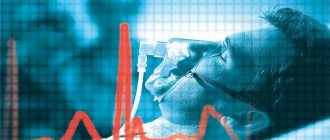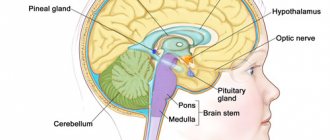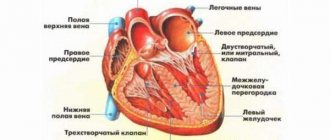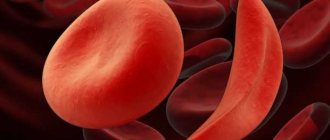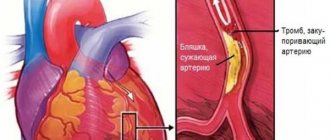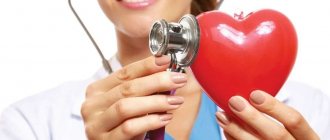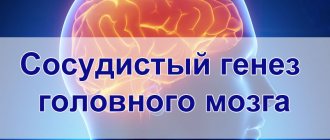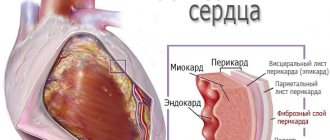Hello, dear readers of Alexey Shevchenko’s blog “Healthy Lifestyle”. In recent years, osteochondrosis has become a disease that not only spoils posture, but also brings many serious complications to the human body. The main disturbance of cardiac rhythm caused by osteochondrosis is extrasystole.
It is important to know: Extrasystole is a disturbance in heart rhythm in the form of untimely or additional (extra) contractions. They can occur either unnoticed or cause very noticeable discomfort to a person. You will learn even more useful information about extrasystole by reading the article to the end, or by looking at other articles about this disease that are posted on our blog. (For example, you can read about the dangers of extrasystole here).
Extrasystole: symptoms and treatment
Image from lori.ru
Extrasystoles are untimely contractions of the heart or its individual chambers; ventricular extrasystole is one of the most frequently recorded types of arrhythmias. This disease can be found in 60-70% of people on earth. It is neurogenic in nature, and this disease can be triggered by severe stress, smoking, drinking alcohol, strong coffee and tea. Also, symptoms of extrasystole can be organic. In this case, extrasystoles are caused by myocardial damage - inflammation, dystrophy, coronary heart disease or cardiosclerosis.
A new untimely impulse can originate from the ventricles of the heart, its atria, as well as from the atrioventricular junction. The occurrence of a disease such as ventricular extrasystole is explained by the presence of a focus of so-called trigger activity. The coupling interval characterizes the relationship in time between the normal and extraordinary impulses.
Etiology of the disease
The causes of extrasystole (including ventricular extrasystole) are: coronary heart disease, acute or chronic heart failure, obstructive chronic pulmonary diseases, as well as acute pulmonary failure. In addition, symptoms of extrasystole can occur due to osteochondrosis of the thoracic and cervical spine, diseases of the abdominal organs. Too frequent intake of cardiac glycosides, aminophylline and B-adrenomimetics can cause extrasystoles, as a result of which it is necessary to begin urgent treatment of extrasystoles. As mentioned above, severe physical and psychological stress, smoking and caffeine can trigger the symptoms of extrasystole.
Symptoms and treatment of extrasystole
When extrasystoles occur, there may be complaints of too strong heart beats and tremors, as well as a feeling that the heart has frozen or stopped. Symptoms of functional extrasystole include pallor, sweating, anxiety, fear, and lack of air. If frequent extrasystoles are observed, this can lead to a decrease in blood flow in the liver and brain by 8-25%, as well as a decrease in cardiac output. Attacks of angina and cerebral circulation disorders can occur with atherosclerosis of the coronary and cerebral vessels.
Treatment of extrasystole includes the elimination of factors that provoke the disease, as well as direct medical intervention. Timely treatment of extrasystole of a neurogenic nature includes recommendations from a nutritionist, adherence to rest and work schedules, exercise, psychotherapy, taking sedatives or tranquilizers (tincture of valerian, diazepam).
Taking specific drugs for the treatment of extrasystoles may be due to the following indications: a feeling of cardiac arrest, extrasystolic allorhythmia, sleep disturbances, early and frequent ventricular extrasystoles. Patients with post-infarction cardiosclerosis must also take special medications to treat extrasystole.
Extrasystole of the ventricles of the heart can be of different gradations. Grade 1-2 disease does not require treatment. The disease of the third gradation can be left without medical intervention if there is no organic damage to the myocardium. With grades 4 and 5 of extrasystole, installation of a special defibrillator is required due to the increased risk of tachycardia or ventricular fibrillation.
Ventricular extrasystole and osteochondrosis
Ventricular extrasystole is one of the most common cardiac dysfunctions. People suffering from such arrhythmia must undergo special treatment and be constantly under medical supervision.
The symptoms of this pathology are not much different from the symptoms of arrhythmia that occurs for other reasons. Patients are concerned about:
- problems in the functioning of the heart, it seems to turn over in the chest;
- weakness;
- constant feeling of discomfort;
- sweating;
- lack of air;
- constant irritability;
- obsessive fear and anxiety;
- dizziness.
Untreated ventricular extrasystole can lead to serious complications:
- blood clots may form, their separation can lead to serious complications;
- due to poor blood circulation in the brain, there is a risk of stroke;
- the heart may stop and clinical death may occur.
When the first signs of arrhythmia appear, it is better to immediately seek medical help and first of all do an ECG. Only after the examination, the doctor prescribes appropriate treatment.
Can extrasystole occur with osteochondrosis?
The appearance of extrasystoles
If the patient experiences chaotic and frequent contractions of the heart, this may be a sign of extrasystole.
The disease is observed in patients with problems of the thyroid gland, lungs and osteochondrosis.
It occurs with the constant appearance of extrasystoles, which regulate the functioning of the heart.
Osteochondrosis, which was caused by problems in the nervous system, contributes to this:
- Stress and tension;
- Overwork;
- Poor nutrition and bad habits;
- Inactivity or sedentary lifestyle.
Osteochondrosis contributes to the formation of osteophytes, as a result of which the narva roots are compressed
Extrasystole in osteochondrosis is divided into several types:
- Rare;
- Average;
- Frequent.
Photo types:
Average Frequent Rare Then the appearance of paired extrasystoles may be observed, which come in a row or even three pairs at a time. But the most difficult to treat is ventricular extrasystole.
Thoracic department
With extrasystole of the thoracic region due to osteochondrosis, frequent arrhythmia, breathing problems and hypertension may occur when two or three shocks occur in a row.
This happens due to overwork, pinched nerves and constant pain that is transmitted from the nervous system to the heart, disrupting its rhythm.
Cervical
A sedentary lifestyle, improper distribution of load and constant tension leads to vertebral protrusion, inflammation of the nerves, incorrect position of the cartilage, which complicates breathing and disrupts the functioning of the heart.
Therefore, extrasystole in osteochondrosis of the cervical spine is no less common, although it develops in patients under 50 years of age.
Accompanied by single tremors with rare frequency.
Lumbar
If the patient remains in a supine position for a long time and resorts to heavy physical activity, the spine loses flexibility, protrusion of the vertebrae and pinching of the vertebrae is observed, leading to osteochondrosis.
And then, the patient suffers from pain, blood clots, blockages and inflammation, which cause extrasystole.
It is diagnosed in the lumbar region in 40% of cases, but treatment takes at least a year.
How to suspect?
Many people would like to know whether extrasystole is possible with osteochondrosis. Of course yes. However, the symptoms of this arrhythmia are not always similar to ordinary arrhythmia. On the other hand, more than half of patients complain more often of arrhythmia than of chest pain. Another similar attack can manifest itself as single/paired heartbeats, and can be caused by disruptions in the functioning of the spine. During osteochondrosis, cartilage and discs are damaged, nerves are pinched, and because of this, the back begins to hurt. All this is completely unhelpful for cardiac activity, and subsequently extrasystole develops.
The older a person is, the higher the likelihood of pathological changes in the pulse. And it is not surprising: activities that imply immobility of the spine make it less and less flexible, which increases the risk of osteochondrosis. For this reason, extrasystole also occurs. The main signs of heart failure:
- a sharp and unexpected increase in heart contractions, its prominent impulse;
- feeling of a frozen heart;
- feeling of the heart tumbling/turning over;
- fear, anxiety;
- lack of air, difficulty breathing;
- fainting;
- heat in the chest;
- heavy sweating;
- muscle tension between the shoulder blades;
- occasionally there is pressing pain in the heart area;
- weakening of the pulse/temporary loss of it;
- upon diagnosis, it becomes clear that blood circulation is slowed down compared to its earlier indicators.
Types of extrasystole in osteochondrosis
The presence of extraordinary contractions can be determined during a cardiogram or Holter monitoring
In such situations, it is important to choose the right treatment. Before this, the frequency of extrasystoles and the type of arrhythmia are determined
People suffering from osteochondrosis may experience the development of:
- Rare extrasystoles. During the day there are no more than 30 of them.
- Average At the same time, there are several hundred extraordinary layoffs.
- Frequent. The number of additional reductions per day exceeds 200.
With osteochondrosis, paired extrasystoles also occur. With bigeminy there are two of them in a row, and with trigeminy there are three.
The severity of the disease is determined by the number of extrasystoles. The more there are, the worse the situation and the more difficulties arise with the selection of treatment.
Reasons for needing therapy
Extrasystole often occurs due to osteochondrosis of the neck. The discs become thinner, and therefore the nerves that transmit impulses to the heart, as well as the vessels that supply it, are seriously compressed. Because of this, the heart begins to work worse, and pain appears at night. It happens:
Due to extrasystoles caused by osteochondrosis, the following complications often develop:
- pathologies of the heart and blood vessels;
- atrial fibrillation.
Both points can ultimately kill the patient. If the pain in the spine also causes heart failure, you need to consult a specialist. When treating, the doctor must consider:
- nature of extrasystole;
- mechanism of action of drugs;
- the effect of medications in each specific situation.
Treatment
The patient is prescribed potassium salts, since it is their lack in the body that leads to weakening of the heart muscle. But you should know that the best effect is possible with extrasystole of the ventricular type. With the supraventricular type, the effect of use is much less, and with functional and reflex pathology, there is no benefit from potassium salts at all.
Potassium chloride works better than others in this case; it is administered intravenously if absorption in the gastrointestinal tract is impaired. The drug reduces myocardial excitability and slows down its conduction.
Panangin contains potassium and magnesium, which helps smooth out the heart rate. Used both in tablet form and intravenously. As the number of systoles decreases, the dosage of the drug is also reduced.
Novocainamide is effective for ventricular extrasystoles. The first time it is administered in small doses intramuscularly or intravenously. In this case, it is imperative to control the pressure, since the drug can cause a sharp decrease in it.
Patients with supraventricular and ventricular extrasystoles are prescribed Ritmilen. It is quickly absorbed and enters the bloodstream. It should be taken in short courses.
Traditional Treatments
If a patient has a moderate or severe form of extrasystole, it is necessary to prescribe effective treatment. The most commonly prescribed drugs are potassium salts. This group has the most noticeable effect on ventricular-type arrhythmias. If the patient has a functional or reflex extrasystole, potassium preparations are ineffective, and it is necessary to select other means.
Potassium-based medications are also effective when the level of the mineral in the body is low. At the beginning of treatment, the patient takes a “loading dose”, which can range from 6 to 14 grams per day. Subsequently, the dosage of the drugs is reduced to 2 g, spread over 2-3 doses per day.
An effective remedy for the treatment of extrasystole caused by osteochondrosis is Panangin . The drug is easy to use; the patient can be prescribed in the form of tablets or a solution for intravenous injection. Typically, the dosage is within the following limits: tablets - 2 pieces 3 times a day, solution - 10 ml, diluted in 20 ml of saline.
The effectiveness of potassium preparations for arrhythmias is due to a decrease in conductivity through the myocardium. But it is very important to closely monitor the level of mineral substances in the blood, electrocardiogram indicators, and also reduce the amount of medications when the patient’s condition improves.
Among other drugs for the treatment of extrasystole, the following are common:
- Beta blockers. Drugs such as Atenolol, Talinolol, Metoprolol, Nebivolol are also used due to their ability to inhibit all 4 main functions of the heart (contractility, conductivity, automaticity, excitability).
- Novocainamide. The drug is usually used for the ventricular form of extrasystole. It is administered first in small doses, then the amount of the administered substance can be increased.
When using Novocainamide, you must remember the significant hypotonic effect that the drug causes.
- Lidocaine. Used in cases where attacks of arrhythmia overlap each other and do not go away for a long time.
Considering that the main pathology is osteochondrosis, the patient can be prescribed therapeutic exercises, massage, ointments and other means for external use that will help cope with the pathology of the intervertebral discs. Physiotherapy, laser therapy or ultrasound therapy sessions are also possible.
For patients suffering from such serious pathologies as osteochondrosis and extrasystole, it is important to maintain a proper diet, including:
- persimmon;
- seaweed;
- beans;
- walnuts, pine nuts;
- potato;
- dried apricots;
- prunes;
- cereals.
Folk remedies
If experts have identified a mild form of extrasystole, which cannot be treated (unless it causes a decrease in the patient’s quality of life and health), or you want to prevent the occurrence of a pathological condition in osteochondrosis, using folk remedies, you can take a closer look at:
- Valerians. Medicinal substances based on the roots of the plant have a sedative effect and will also help relieve chest pain, reduce tension in the nervous system, increase vascular tone, and restore a healthy emotional background.
- Calendula. The plant is particularly effective in preventing attacks of arrhythmia of various etiologies. The use of calendula-based products leads to normalization of heart rate, increased bile secretion, normalization of blood pressure levels, the state of the nervous system, as well as better blood circulation in the coronary vessels (thanks to the latter effect, the plant prevents the occurrence or spread of foci of ischemic damage to the heart muscle).
- Melissa. The main effects that are characteristic of products based on this plant are anti-inflammatory, analgesic and disinfectant. Melissa also contains many useful microelements and vitamin C, which plays an important role in the treatment of the previously mentioned pathologies.
- Horsetail. Infusions made from the plant help strengthen the walls of blood vessels, lower blood pressure and promote increased removal of toxic substances from the body.
Before using traditional medicine, do not forget to consult your doctor.
Diagnosis of the disease and methods of treatment
Treatment is prescribed by the doctor based on determining the form of the extrasystole disease. If it is mild, then medication treatment is not prescribed, although it cannot be ignored. It is worth undergoing a full examination in order to eliminate all causes that may affect the further development of the disease. After all, it is known that a mild form can easily develop into a more complex one.
If the patient has a number of extrasystoles exceeding 700 beats per day, it is necessary to prescribe effective treatment. If you feel severe chest pain, you should consult a cardiologist. In due time, the doctor must listen to the patient’s complaints and conduct a special diagnosis. The first thing the doctor should do is measure your blood pressure, listen to your heart and prescribe blood and urine tests. Next you need to send for an ECHO and ECG. In order to measure the frequency of extrasystoles, Holter monitoring is prescribed to the patient. This technique takes longer, but it shows the rate of contraction of the human heart. Ultrasound and MRI are required.
Treatment of extrasystole for osteochondrosis is prescribed by a doctor. But the first thing worth remembering is the mode
It is necessary to go to bed on time, do exercises, and regulate nutrition (it is important to include foods rich in potassium in the patient’s menu, and exclude alcohol, coffee and carbonated drinks). If rapid heartbeat is caused by anxiety or stress, then the patient is prescribed sedatives and tranquilizers
For many, going to see a doctor is a serious move, so there are also folk remedies for curing the disease, but remember that self-medication can lead to serious consequences. The most important thing is to get advice from an experienced specialist and accurately determine the causes of extrasystole.
How is pathology diagnosed?
Extrasystole in osteochondrosis of the thoracic region and other parts of the spine is determined by echocardiography and Holter monitoring. If there is a need for this, they can resort to laboratory and instrumental methods.
Also read: First aid for low heart rate: what to do at home In the diagnostic process, it is important not only to confirm the diagnosis, but also to determine the reason for the appearance of extraordinary contractions. Based on the examination results, the most suitable treatment option is selected.
It is important to know that therapy in the presence of heart pathologies differs significantly from that prescribed to eliminate extrasystoles of functional and toxic origin.
If the rhythm disturbance is mild, then special healing methods are not resorted to, since extraordinary contractions do not cause significant discomfort.
But in order to determine what caused the disruption in heart rhythm and successfully correct the situation, it is necessary to conduct a comprehensive examination.
The entire diagnostic process consists of:
- Examination and consultation with a cardiologist. He listens for murmurs in the heart and lungs, measures blood pressure, and examines the skin and subcutaneous fat. Carries out a study of the characteristics of the patient's body. All these procedures facilitate the process of determining the factor that provoked extrasystole. The doctor records the frequency with which the muscles contract.
- Blood and urine tests. This is necessary to identify the presence of an inflammatory process in the body.
- Electrocardiography and echocardiography. These techniques detect rhythm disturbances and structural and morphological changes in the heart.
- Holter monitoring, in which heart performance indicators are recorded throughout the day. The procedure can be carried out over one or several days. The patient is wearing a sensor that records all rhythm fluctuations. All data is then studied and conclusions are drawn about the work of the heart at different times of the day.
- Load tests. Sometimes, to obtain more detailed information about the work of the heart, stress tests are performed, during which a cardiogram is recorded while exercising on an exercise bike or treadmill.
To obtain comprehensive information about the condition of the body, magnetic resonance imaging may be prescribed.
Treatment of arrhythmia resulting from osteochondrosis
If osteochondrosis caused the onset of extrasystole, it cannot be treated as usual: this will only worsen the disease.
Having found out the cause, you can begin therapy. It's best to proceed in stages. Here are the most important stages of treatment:
- return of metabolism to normal;
- correction of diet;
- if necessary, losing extra pounds;
- in advanced cases - the use of drugs designed to combat arrhythmia;
- a course of gentle manual therapy.
Usually it is not enough to cure a person of osteochondrosis just once. After all, even if such a disease is cured, it can strike again at any moment. So prevention of osteochondrosis must be done throughout your life. And sometimes it is recommended to use medications against arrhythmia for months after recovery so that it does not return again.
Treatment in each case must be developed by a doctor. Moreover, it is best to consult with several at once. Even chronic osteochondrosis may not be the main cause of extrasystole. It is often the result of a combination of several factors:
- certain volumetric processes;
- poisoning of the body due to chronic sluggish infections;
- poisoning of the body is unknown by what and because of what;
- hyperthyroidism;
- allergies;
- hypertension.
If extrasystole is not treated, other heart-related pathologies may develop.
During osteochondrosis, the severity of chest pain is always different. At first, the pain is sharp, and sometimes the neck, shoulder blades, and fingers go numb. Then the pain becomes dull, constantly aching. Usually older people get sick, especially those who work while sitting. So the best prevention of this is movement and sports.
If the source of the disease is in the neck
Extrasystole usually develops due to disorders of the locomotor system in the neck. The patient's heartbeat is abnormal and there may be pain in the heart area. Using an ECG, the problem can only be identified during an attack. Then the circulatory disorder becomes noticeable.
This compresses the vertebral artery, thereby preventing it from delivering a sufficient amount of necessary substances to the brain tissue. Then a lack of oxygen appears in the brain, and hypoxia begins. Ultimately, this leads to disruption of the myocardium.
Therapeutic measures and prevention of the development of the condition
First you need to visit a therapist. The specialist will collect anamnesis, the patient’s complaints and refer him for initial examinations, such as a blood test and determination of blood pressure readings, an electrocardiogram. Then a consultation with specialized doctors, usually cardiologists, may be indicated.
Then the patient is referred for more detailed examinations:
- Ultrasound of the heart muscle. Detects the presence of pathological changes in tissues and organ structure.
- Holter electrocardiogram. To do this, special sensors are attached to the patient in the area of the heart muscle, and a special device reads information from them throughout the day. Subsequently, the data obtained is analyzed and a pattern between the occurrence of attacks and daily activity is revealed.
- MRI. It is performed quite rarely, usually in advanced cases. The method allows you to identify pathological changes in the heart muscle and blood vessels.
- Bicycle ergometry. The patient performs physical activity on a special simulator, and the doctor notes changes in heart rhythm. The method is good for identifying secretly ongoing processes.
Correct diagnosis is the path to recovery
To confirm extrasystole provoked by osteochondrosis, the following diagnostic methods are used:
To confirm the diagnosis, the patient needs to undergo an ECG.
- Electrocardiography. Evaluates heart conditions through electrical impulses passing through the muscle.
- Holter monitoring. Records ECG readings throughout the day during a person’s normal life rhythm.
- MRI of the heart. Detects pathologies of the myocardium, its valves and blood vessels. Examines blood flow and changes in the cardiac artery.
- CT scan of the spine. Gives a detailed description of the vertebrae, their processes, and intervertebral discs. Evaluates their connection with the spinal cord.
- MRI of all parts of the spine. Shows a complete picture of structural changes in bone and soft tissues.
In severe cases of extrasystoles, one-week or two-week ECG studies are prescribed, which require hospitalization of the patient.
Main directions of therapy
As mentioned above, extrasystoles in osteochondrosis are not directly related to cardiac dysfunction. They disappear when the underlying disease is relieved. However, it is not possible to cure osteochondrosis changes in the spine using the usual method and without harming the heart. Therefore, a comprehensive rehabilitation plan is drawn up that takes into account ways to solve both problems. It consists of the following points:
- It is necessary to streamline the metabolic processes of the patient's body. A balanced diet enriched with calcium and magnesium salts is prescribed. Drinking coffee, strong tea, and alcoholic beverages is not recommended.
- Taking medications that calm and normalize heart rhythm.
- Exercise therapy classes according to a special program taking into account the condition of both the spinal column and the cardiovascular system.
- Medical massage, which is prescribed after stabilization of the heart rhythm.
The therapeutic plan also largely depends on the frequency of extrasystole attacks. If symptoms occur rarely, no treatment is prescribed, but the frequency of attacks must be monitored. If their number increases, you should immediately contact a cardiologist.
Therefore, in this case, the following medicinal substances are used:
- Sedatives, such as various herbal infusions (for example, infusions of lemon balm, hawthorn) or tranquilizers in small doses.
- ß-blockers, for example, Anaprilin.
Most often, this will be more than enough to stabilize the clinical picture.
However, in the event of an exacerbation of the process and when frequent attacks of pathology occur, the dosage of drugs that stabilize the arrhythmia (for example, mexilen, amiodarone) is selected for the patient in a hospital setting under ECG monitoring during the day (Holster method).
Treatment of the disease
Treatment of extrasystoles in osteochondrosis must be started if more than 200 extrasystoles are observed per day and the diagnosis has been confirmed by doctors. Different methods are used for this, each of them is effective in its own way.
Medicines
For severe pain, painkillers are used. If the heart muscle contracts abnormally due to fear or anxiety, doctors recommend resorting to sedatives.
Sometimes arrhythmia can be a consequence of taking medications. It is important to find out which of them the patient reacts to and try to choose a different treatment regimen.
In addition to these measures, the doctor may prescribe medications that help restore metabolism and lower blood pressure.
Manual therapy
This method of treating arrhythmia is considered quite effective. With its help, muscle spasms are relieved, the metabolic process in the body and blood flow are improved. It is only important to approach this issue seriously and entrust yourself exclusively to a qualified specialist, because unprofessional actions can aggravate the situation and cause serious harm to the patient.
Physiotherapy
Among the physiotherapeutic methods for treating extrasystole, therapeutic exercises and massage have proven themselves well. It is only important not to use them during an exacerbation. Individual physiotherapy is selected for each patient.
Traditional therapy
Traditional methods of treating arrhythmia cannot be treated as the main ones. They are more suited to a supporting role.
Recipe No. 1
To prepare this folk remedy you will need 4 tsp. valerian root and 1 tbsp. water. This mixture is simmered in a water bath for half an hour, filtered and taken three times a day, 1 tbsp. l. after eating.
Recipe No. 2
Using lemon and garlic gives positive results. To prepare this folk recipe, you need to take 6 cloves of garlic and 2 lemons, pass it all through a meat grinder, put it in a three-liter jar and fill it with water. Take half a glass of the tincture once a day. This is an excellent cleanser for blood vessels, which has a beneficial effect on the functioning of the heart.
Recipe No. 3
Motherwort decoction has excellent sedative properties. To prepare it you need 1 tbsp. l. steam motherwort in 1 tbsp. water. This remedy is taken for 14 days three times, 1 tbsp. l. before eating.
Drug treatment
Treatment with antiarrhythmic drugs for extrasystole is carried out only if the cause is heart pathology (read about the drugs used here). In cases of osteochondrosis, proper rehabilitation can improve the condition and eliminate rhythm disturbances.
To stop an exacerbation, the following drugs are taken:
- Non-steroidal anti-inflammatory drugs (Ibuprofen, Diclofenac). They relieve pain and swelling in the affected area.
- Muscle relaxants (“Sirdalud”, “Mydocalm”). Relieves muscle spasm.
- In case of severe infringement, corticosteroids are used or a novocaine blockade is performed.
To prolong remission, massage and physical therapy are used. In very advanced cases, surgery is recommended to eliminate pinched nerves and restore blood flow and nerve conduction.
Case from practice
A patient came to see me at the clinic with complaints of sensations of paroxysmal interruptions in the heart that occur periodically during hard work. Palpation revealed pain in the thoracic spine. Single extrasystoles from the atrioventricular junction were recorded on the ECG. No ischemia or other signs of cardiac pathology were detected. After a week of taking Naklofen and Sirdalud, as well as topical use of Diclofenac ointment, the condition improved and the patient stopped feeling interruptions.
Definition of the term
Extrasystole refers to heart rhythm disturbances and is considered the most common form of arrhythmia. The pathological process is characterized by premature, uncontrolled muscle contraction in response to an impulse. Signals for contraction or extrasystoles can occur in any part of the heart. Their manifestation consists of additional beats against the background of the main pulse. Before their occurrence there is a short pause, and after additional contractions the interval increases noticeably, which creates the impression of cardiac arrest.
Causes for osteochondrosis
Poor circulation leads to pathologies of the heart muscle.
There is a close connection between degenerative changes in the spine and heart rhythm disturbances. More often, extrasystole with chondrosis is observed in the later stages of the underlying disease, when degenerative processes lead to active destruction of cartilage tissue, which causes displacement of the vertebrae. In this case, there is infringement of large arteries and nerve fibers. Extrasystole with osteochondrosis of the thoracic region has a progressive nature. During physical activity, compression of the intercostal nerves is observed, which leads to myocardial dysfunction. This condition is accompanied by a rapid heartbeat with a reduction in the interval between beats. An advanced form of chondrosis leads to prolonged infringement of nerves, blood vessels and hypoxia of the heart muscle. Due to a deficiency of nutrients and oxygen in the myocardium, extrasystoles occur, which is manifested by an accelerated heartbeat.
Extrasystole is often observed with osteochondrosis of the cervical spine, which is associated with a change in the anatomical position of the vertebrae due to degenerative disorders. This causes increased pressure on the intervertebral artery, which supplies the brain. Due to the infringement of the lumen, there is incomplete saturation of the vessel with blood, which leads to hypoxia of the brain, which sends a signal to the central nervous system. At the same time, an impulse is sent to the heart, which provokes an accelerated contraction. Prolonged disruption of blood flow leads to the development of arrhythmia.
Clinical picture and complications
With classic extrasystole, the following clinical picture :
- a feeling of strong heartbeat, which can even interfere with restful rest;
- skin cyanosis;
- increased sweating;
- periodic sensations of cardiac arrest or lack of pulse;
- lack of oxygen, manifested by blueness of the corners of the mouth.
With extrasystole caused by osteochondrosis of the cervical intervertebral discs , these symptoms are accompanied by an increased level of blood pressure, pre-syncope, and there will be no sensation of lack of pulse. In the vast majority of cases, the pulse will only increase.
A distinctive feature of extrasystole caused by osteochondrosis of the thoracic intervertebral discs is the appearance of excessively severe chest pain. The type of arrhythmia itself will be functional, but the sensations will be so acute that some people compare them with the pain that occurs during a myocardial infarction.
Among the complications , two groups can be distinguished, which may appear as a result of the first or second pathology.
In severe forms of osteochondrosis, in addition to extrasystole, the patient may experience:
- Protrusion of intervertebral discs.
- Intervertebral hernia.
- Malfunction of the visual analyzer.
- Damage to the cochlea and the vestibular apparatus as a whole.
Pathological changes in the cochlea are accompanied by a disturbance in the perception of sound vibrations, and therefore in hearing in general. Damage to the vestibular apparatus will lead to impairment of movements and spatial orientation.
- Acute pain in the lower back.
- Prolapse of intervertebral discs.
- Spinal canal stenosis.
If chest pain caused by extrasystole is ignored for a long time, the patient may experience:
- Blood clots in blood vessels, which, having partially detached from the vessel wall, turn into a thromboembolus. For human life, blockage of blood vessels by the first and second formations is extremely dangerous.
- Hypoxia of the brain caused by insufficient blood circulation. The condition is fraught with the fact that the risk of a stroke in a person increases significantly, as does the likelihood of the appearance of foci of ischemia.
- Sudden cardiac arrest. In this condition, symptoms of clinical death develop, often leading to death.
Can osteochondrosis cause extrasystole?
Osteochondrosis is a complex of dystrophic disorders in articular cartilage. At the same time, extrasystole is understood as untimely depolarization and contraction of the heart and its individual structures. This pathology is the most common type of arrhythmia. How can these diseases be related, and can the first cause the second?
With osteochondrosis, the patient often experiences pain in the heart, which is most often a manifestation of pathological deformations of the intervertebral discs.
As you know, the spinal cord runs inside the vertebral bodies, and the slightest changes in the structures of the spinal column can cause compression of the anterior horns of this part of the nervous system. These structures contain motor nuclei, which are responsible for efferent innervation and transmit signals to the periphery (receptive organs consisting of muscle fibers). Due to compression, the anterior horns of the spinal cord are irritated, sending a signal to the myocardium, in which nerve fibers are also excited and impulses are transmitted to the cortical parts of the brain, which leads to pain.
The most common cause of heart pain is cervical and upper thoracic osteochondrosis. In general, there are 2 ways of causing pain in the heart with osteochondrosis:
- Direct, in which pain is localized in the heart. The cause is impulses transmitted by the fibers of the sympathetic nervous system. In this case, the essence of the problem lies in the disruption of the processes of innervation of the central organ of the cardiovascular system.
- Reflex, which develops due to irradiation of pain from the left arm or shoulder girdle. The cause of unpleasant sensations in these areas also arises due to disruption of their innervation due to osteochondrosis of the intervertebral discs of the cervical and thoracic spine.
Extrasystole occurs with multiple repetitions of heart pain and prolonged, advanced osteochondrosis. Heart rhythm disturbances and altered innervation in the initial stages of the disease will be short-lived.
At first, the phenomena of extrasystole can be detected only after physical exertion. As a result of the fact that chronic myocardial hypoxia occurs in parallel, blood will not be pushed as efficiently as during normal operation, which is why the heart needs additional contractions.
With thoracic osteochondrosis, the cardiac nerve can be compressed, which directly affects the heart rhythm.
Extrasystoles in osteochondrosis can manifest themselves to varying degrees, which is why they are divided into:
- Rare - single attacks of arrhythmia occur, maximum - up to several dozen times a day.
- Medium - extrasystoles appear several hundred times a day.
- Frequent – attacks of arrhythmia occur, repeating thousands of times a day.
Symptoms
The initial stage of the pathology is characterized by the fact that extrasystoles in osteochondrosis are manifested by a constant feeling of muscle tension and tissue soreness. Such symptoms significantly limit the patient’s motor activity; discomfort interferes with the natural movements of the body, upper and lower extremities.
Since the pain syndrome at the onset of the disease is not pronounced, patients rarely seek qualified medical help, believing that the pain will go away spontaneously. Ignoring symptoms can lead to their intensification, which becomes a frightening factor.
Additional signs of extrasystole in osteochondrosis are the following conditions:
- sudden shocks of the heart, accompanied by periodic freezing for several seconds. After this, the heart muscle begins to contract rapidly;
- discomfort, tension in the subscapular area;
- disorientation in space, accompanied by fainting;
- sudden hot flashes, sweating, chills;
- feeling of lack of air to take a deep breath;
- general weakness, blue lips;
- pale skin;
- irregular pulse, sudden jumps in blood pressure.
The occurrence of such symptoms should alert a person and prompt them to seek the necessary medical help. Otherwise, an increase in discomfort in the spine and other areas of the body can lead to serious psychological problems, which will require consultation with a psychotherapist and the prescription of appropriate treatment.
ethnoscience
When treating extrasystole against the background of osteochondrosis, any self-medication is contraindicated. A doctor's help is needed here. But sometimes traditional medicine is also useful.
There are three groups of raw materials that are the basis for traditional medicines.
First group
Herbal preparations. Moreover, the vegetation can be of any kind, as long as it contains a lot of magnesium and potassium. The following plants are good to use:
It is useful to use essential oils: they heal the body.
There are also useful herbs.
Calendula is an excellent remedy for preventing arrhythmic attacks. Preparations based on it:
- normalizes the pulse;
- increase the secretion of bile;
- bring pressure back to life;
- restore the nervous system;
- improve blood flow through the coronary vessels.
The latter effect is extremely useful in preventing cardiac ischemia from developing or occurring.
Melissa effectively fights inflammation, pain, and infections. It is very rich in trace elements and ascorbic acid, and therefore is extremely useful for the treatment of extrasystole and osteochondrosis.
Horsetail infusions are good for the following:
- strengthening vascular walls;
- decrease in pressure;
- improving the removal of toxins.
Second group
Medicines based on animal raw materials. These are a variety of ointments. Very good for the treatment of advanced osteochondrosis in combination with mild extrasystole.
Third group
Medicines that are chemical products. This includes all analgesics, including ordinary analgin. Turpentine-based ointments, alcohol, tincture of iodine - these are the products that can be used to achieve the following effects:
- pain relief;
- warming;
- regeneration of bones and muscles.
At the same time, they do not have a side effect that disrupts the already disturbed heartbeat rhythm.
And there are also allergies to folk remedies, so caution is needed here. Before using them, you should make sure that there are no allergic reactions to the corresponding drugs
Before using products that contain any poisons, you should consult a doctor to obtain all the required information on such products. Consultation is most important before using medications containing snake venom.
Extrasystole as a concomitant disease of osteochondrosis
Extrasystole and osteochondrosis are diseases that often go hand in hand, and treating them together is quite difficult.
In addition, after completing the course of treatment, the patient will have to follow a strict medical prescription for physical activity, as well as significantly reduce his daily diet in terms of fatty substances and some proteins. And also include as many foods containing potassium in your menu as possible. Beans, prunes, seaweed and green tea or herbal teas will be good helpers for your body.
Important! It is worth eliminating alcohol, strong coffee and sweet carbonated water completely from your diet. Don't overwork your body.
